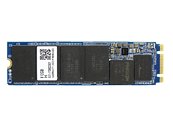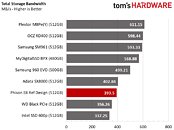Raevenlord
News Editor
- Joined
- Aug 12, 2016
- Messages
- 3,755 (1.18/day)
- Location
- Portugal
| System Name | The Ryzening |
|---|---|
| Processor | AMD Ryzen 9 5900X |
| Motherboard | MSI X570 MAG TOMAHAWK |
| Cooling | Lian Li Galahad 360mm AIO |
| Memory | 32 GB G.Skill Trident Z F4-3733 (4x 8 GB) |
| Video Card(s) | Gigabyte RTX 3070 Ti |
| Storage | Boot: Transcend MTE220S 2TB, Kintson A2000 1TB, Seagate Firewolf Pro 14 TB |
| Display(s) | Acer Nitro VG270UP (1440p 144 Hz IPS) |
| Case | Lian Li O11DX Dynamic White |
| Audio Device(s) | iFi Audio Zen DAC |
| Power Supply | Seasonic Focus+ 750 W |
| Mouse | Cooler Master Masterkeys Lite L |
| Keyboard | Cooler Master Masterkeys Lite L |
| Software | Windows 10 x64 |
Phison has been working hard towards bringing to market a new, budget SSD controller in the form of its Phison E8 solution. The controller was designed with the purpose to try and dethrone Intel's 600p solutions from the budget, entry-level NVMe options, through offering increased performance at the same affordable prices. To do this, and so as to decrease power consumption, Phison opted for a PCIe 2x support for the E8 - this means the company is trading burst performance for decreased power consumption. E8-based SSDs are expected in capacities of 128 GB, 256 GB, 512 GB, and 1 TB, with prices lower than the current 600p and Phison's own E7-based products like the MyDigitalSSD BPX.
The Phison E8 controller should still offer plenty of increased performance over a typical HDD, and has been designed to work with 3D NAND technology. even with the firmware in its non-final stages, Tom's Hardware is reporting that the Phison E8's performance is already higher than Intel's 600p and WD's Black PCIe solutions. As we all know, though, firmware optimizations are paramount to SSD controllers' performance, so we can only expect these performance numbers to go up. All in all, it seems we'll have yet another low-cost NVMe SSD solution in the market, though desktop users will likely opt for a PCIe 4x solution, since that environment doesn't care about power consumption as much as a mobile solution would.


View at TechPowerUp Main Site
The Phison E8 controller should still offer plenty of increased performance over a typical HDD, and has been designed to work with 3D NAND technology. even with the firmware in its non-final stages, Tom's Hardware is reporting that the Phison E8's performance is already higher than Intel's 600p and WD's Black PCIe solutions. As we all know, though, firmware optimizations are paramount to SSD controllers' performance, so we can only expect these performance numbers to go up. All in all, it seems we'll have yet another low-cost NVMe SSD solution in the market, though desktop users will likely opt for a PCIe 4x solution, since that environment doesn't care about power consumption as much as a mobile solution would.


View at TechPowerUp Main Site
Last edited:








